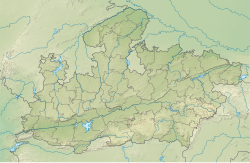Tughluq Shāhī Mosque
| Tughluq Shāhī Mosque | |
|---|---|
 The prayer hall, looking north, 1982 | |
| Religion | |
| Affiliation | Islam (former) |
| Ecclesiastical or organizational status | Mosque (former) |
| Status | Inactive; (partial ruinous state) |
| Location | |
| Location | Udaypur, Vidisha district, Madhya Pradesh |
| Country | India |
Location of the former mosque in Madhya Pradesh | |
| Geographic coordinates | 22°35′02″N 75°17′53″E / 22.584°N 75.298°E |
| Architecture | |
| Type | Mosque architecture |
| Completed | AH 739 (1338/1339 CE) |
| Official name | Tughluq Shāhī Mosque |
| Reference no. | N-MP-289 |
The Tughluq Shāhī Mosque is a former small mosque, now in partial ruins, located west of the Nīlakaṇṭheśvara temple, in Udaypur, in the Vidisha district of the state of Madhya Pradesh, India. The mosque was constructed in the time of Muḥammad bin Tughluq (1325–51).[1] The building is part of a protected Monument of National Importance under the jurisdiction of the Archaeological Survey of India.
Description
[edit]The mosque consists of a covered prayer hall, built on the temple platform. It incorporates a number of older pillars, and preserves the balcony seats with sloping backs (kakṣāsna) that once surrounded most of the temple complex. A small arched mihrab was added to the western wall at the time construction.[2][3][4]
The mosque was built in the 14th century, as testified by two inscriptions on small arched gates still standing either side of the Śiva temple.[5] These inscriptions date AH 739 (1338/1339 CE).[6][7][8]
"Hath said the Prophet, may God’s peace and blessings rest upon him: “He who builds a masjid in this world, God Almighty builds (for him) a palace in Paradise.” (Was built) this mosque during the reign and khilāfat (viceroyalty of) sovereign of kings, Abū’l-Mujāhid (Father of Warriors) Muḥammad son of Tughlaq, may his rule and kingdom be perpetuated. The builder of this pious (work is the) humble Aḥmad Wajih, (may) God enhance his dignity. (In the) year 737."
Gallery
[edit]See also
[edit]References
[edit]- ^ Jackson, Peter A. (1999). The Delhi Sultanate: A Political and Military History. Cambridge: Cambridge University Press.
- ^ Cunningham, A. Archaeological Survey of India Reports. Vol. 10. p. 68.
- ^ Patil, D. R. (1952). The Descriptive and Classified List of Archaeological Monuments in Madhya Bharat. Gwalior: Dept. of Archaeology, Madhya Bharat Government.
- ^ Indian Archaeology: A Review. 1983–84. p. 56.
- ^ "Entrance to the courtyard with Persian and Arabic inscription, dated in the mid-fourteenth century CE" (An old photograph). Zenodo. Udaypur उदयपुर, Madhya Pradesh: Archaeological Survey of India. 2024.
- ^ Rahim, Syed Abdur (2000). Arabic, Persian and Urdu Inscriptions of Central India: A Topographical List. New Delhi: Sundeep Prakashan. p. 122.
- ^ a b Saksena, R. (1926). "Muslim Epigraphy in the Gwalior State". The Indian Antiquary (55): 4–5.
- ^ Desai, Z. A. (1964–65). ARIE. p. 23.
External links
[edit]![]() Media related to Tughluq Shāhī Mosque at Wikimedia Commons
Media related to Tughluq Shāhī Mosque at Wikimedia Commons


